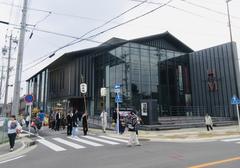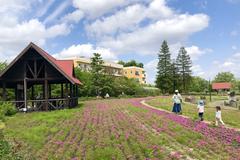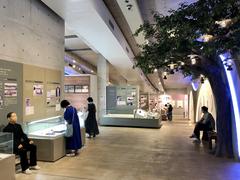Comprehensive Guide to Visiting Tokoname Pottery Footpath Handa Japan
Date: 23/07/2024
Introduction
Discover the enchanting world of Tokoname Pottery Footpath in Handa, Japan, a historic route that immerses visitors in the age-old art of pottery making. Tokoname, one of Japan’s Six Ancient Kilns, boasts a rich history dating back over a millennium, originating in the Heian period (794-1185). This guide provides an in-depth exploration of Tokoname pottery, tracing its evolution from the Heian period through the Kamakura, Muromachi, Edo, and Meiji periods, right up to the present day. Visitors can traverse the Tokoname Pottery Footpath, a curated route that showcases traditional kilns, artisan workshops, and galleries. The footpath offers a unique glimpse into the techniques and cultural significance of Tokoname pottery, making it a must-visit for ceramic enthusiasts and cultural explorers alike (source).
Table of Contents
- Introduction
- Origins and Early Development
- Kamakura and Muromachi Periods
- Edo Period - Expansion and Innovation
- Meiji Period - Industrialization and Modernization
- Showa Period to Present Day
- Cultural Significance
- Notable Pottery Styles and Techniques
- Visitor Information
- Special Events and Guided Tours
- Preservation and Promotion
- FAQ
- Conclusion
Exploring the Rich History and Cultural Significance of Tokoname Pottery
Origins and Early Development
Tokoname pottery, originating from Tokoname City in Aichi Prefecture, Japan, is one of the Six Ancient Kilns of Japan, with a history dating back over 1,000 years. The earliest evidence of pottery production in Tokoname dates to the Heian period (794-1185). During this time, the region’s abundant natural resources, including high-quality clay and access to the sea for transportation, facilitated the growth of pottery as a significant local industry.
Kamakura and Muromachi Periods
The Kamakura (1185-1333) and Muromachi (1336-1573) periods saw the evolution of Tokoname pottery techniques and styles. Potters began to produce larger items such as storage jars and water containers, which were essential for daily life and trade. The kilns used during this period were primarily anagama (single-chambered) and noborigama (multi-chambered climbing kilns), which allowed for higher firing temperatures and more consistent results.
Edo Period - Expansion and Innovation
The Edo period (1603-1868) marked a significant expansion in the production and variety of Tokoname pottery. This era saw the introduction of red clay teapots, known as “kyusu,” which became highly popular for their aesthetic appeal and functionality. The development of these teapots was influenced by the tea culture that flourished during the Edo period. Tokoname potters also began to experiment with glazes and decorative techniques, leading to a broader range of products.
Meiji Period - Industrialization and Modernization
The Meiji period (1868-1912) brought about industrialization and modernization in Japan, which significantly impacted Tokoname pottery. The introduction of Western technologies and techniques allowed for mass production and the creation of new types of pottery. During this time, Tokoname became known for its production of sewer pipes and tiles, which were essential for Japan’s rapidly developing infrastructure.
Showa Period to Present Day
The Showa period (1926-1989) and the subsequent Heisei (1989-2019) and Reiwa (2019-present) periods have seen Tokoname pottery maintain its traditional roots while also embracing contemporary styles and techniques. Today, Tokoname is renowned for its high-quality teapots, which are prized by tea enthusiasts worldwide. The city continues to be a hub for ceramic arts, with numerous workshops and galleries showcasing the work of both traditional and modern potters.
Cultural Significance
Tokoname pottery holds a significant place in Japanese culture and history. The craftsmanship and techniques developed over centuries have been passed down through generations, preserving the unique characteristics of Tokoname ware. The pottery is not only functional but also an art form that reflects the cultural heritage of the region.
Notable Pottery Styles and Techniques
Tokoname Kyusu (Teapots)
One of the most iconic products of Tokoname pottery is the kyusu, a traditional Japanese teapot. These teapots are typically made from red or black clay and are known for their fine craftsmanship and ergonomic design. The clay used in Tokoname kyusu is rich in iron, which is believed to enhance the flavor of the tea. The teapots are often unglazed, allowing the natural beauty of the clay to shine through.
Shudei (Red Clay)
Shudei, or red clay, is a distinctive feature of Tokoname pottery. This clay is rich in iron oxide, giving it a characteristic reddish-brown color. Shudei is often used for making teapots and other functional items. The clay’s natural properties are believed to improve the taste of tea, making it a popular choice among tea connoisseurs.
Yakishime (High-Fired Unglazed Ware)
Yakishime refers to high-fired, unglazed pottery that is characteristic of Tokoname ware. This technique involves firing the pottery at high temperatures, resulting in a durable and aesthetically pleasing finish. Yakishime pottery often features natural ash glazes that form during the firing process, adding unique textures and colors to each piece.
Visitor Information
Planning a visit to explore Tokoname pottery? Here are some essential details:
- Tokoname Pottery Visiting Hours - Most workshops and galleries are open from 10 AM to 5 PM, but it’s advisable to check individual locations for specific timings.
- Tokoname Pottery Tickets - Entry to most galleries and workshops is free, but some may charge a small fee for guided tours or special exhibitions.
- Travel Tips - Tokoname City is accessible via the Meitetsu Tokoname Line, with frequent trains from Nagoya. Consider purchasing a day pass for unlimited travel.
- Nearby Attractions - Don’t miss the Tokoname Pottery Footpath, INAX Live Museum, and the historic climbing kilns.
- Accessibility - Most major attractions are wheelchair accessible, and English-speaking guides are available at popular sites.
Special Events and Guided Tours
Tokoname City hosts several pottery-related events throughout the year:
- Annual Tokoname Pottery Festival - Held in early October, this festival features live demonstrations, workshops, and a market where you can purchase unique pottery pieces.
- Guided Tours - Many workshops offer guided tours, providing insights into the pottery-making process and the history of Tokoname ware.
- Photographic Spots - Capture the beauty of Tokoname pottery at iconic locations like the Dokanzaka (Pottery Path) and the traditional climbing kilns.
Preservation and Promotion
Efforts to preserve and promote Tokoname pottery have been ongoing, with various initiatives aimed at supporting local artisans and educating the public about this traditional craft. The Tokoname Ceramic Art Institute and the Tokoname Pottery Footpath are two key institutions dedicated to the promotion of Tokoname pottery.
Tokoname Ceramic Art Institute
The Tokoname Ceramic Art Institute offers workshops, exhibitions, and educational programs to promote the art of pottery. It serves as a hub for both local and international artists, fostering a community of ceramic enthusiasts and professionals.
Tokoname Pottery Footpath
The Tokoname Pottery Footpath is a popular tourist attraction that allows visitors to explore the historic pottery district of Tokoname. The footpath features numerous kilns, workshops, and galleries, providing an immersive experience into the world of Tokoname pottery. Visitors can observe artisans at work, purchase unique pottery pieces, and learn about the history and techniques of Tokoname ware.
FAQ
What is Tokoname pottery?
Tokoname pottery is a traditional Japanese ceramic ware originating from Tokoname City in Aichi Prefecture, known for its high-quality clay and unique styles.
How is Tokoname pottery made?
Tokoname pottery is made using local clay, often high-fired in anagama or noborigama kilns, and may feature techniques such as yakishime and shudei.
Where can I buy Tokoname pottery?
You can purchase Tokoname pottery at local workshops, galleries, and during the annual Tokoname Pottery Festival. Many pieces are also available online.
Conclusion
The history of Tokoname pottery is a testament to the enduring legacy of Japanese craftsmanship and cultural heritage. From its origins in the Heian period to its modern-day prominence, Tokoname pottery continues to captivate and inspire. The dedication of local artisans and the support of institutions like the Tokoname Ceramic Art Institute ensure that this ancient craft will continue to thrive for generations to come.
For more information on Tokoname pottery, visit the Tokoname City official website.
Visit and Stay Up to Date
To keep up with the latest news on Tokoname pottery and other related topics, follow us on social media and check out our other posts. Download the Audiala mobile app for an enhanced experience with interactive tours and exclusive content.
Explore the Tokoname Pottery Footpath - Visiting Hours, Tickets, and Historical Insights
Historical Background
The Tokoname Pottery Footpath, located in Handa, Japan, is a testament to the region’s rich ceramic history. Tokoname is one of Japan’s Six Ancient Kilns, with pottery production dating back to the Heian period (794-1185). The area became renowned for its high-quality ceramics, particularly during the Edo period (1603-1868), when Tokoname ware was widely distributed across Japan. The footpath itself is a curated route that showcases the historical and cultural significance of Tokoname pottery, offering visitors a unique glimpse into the traditional craft that has shaped the region’s identity (source).
Key Attractions Along the Footpath
Dokanzaka (Clay Pipe Hill)
One of the most iconic spots along the Tokoname Pottery Footpath is Dokanzaka, also known as Clay Pipe Hill. This steep slope is lined with thousands of clay pipes and shochu (Japanese liquor) bottles embedded in the walls, creating a visually striking pathway. These pipes and bottles were originally produced in Tokoname and are a testament to the area’s industrial past. Walking up Dokanzaka offers a tactile connection to the history of Tokoname pottery.
Climbing Kilns
The footpath features several climbing kilns, or noborigama, which are traditional multi-chambered kilns built on slopes. These kilns were used to fire large quantities of pottery and are an engineering marvel. Visitors can explore these kilns and learn about the firing process, which involves stacking pottery in the chambers and firing them sequentially. The preserved kilns along the footpath provide a tangible link to the past and illustrate the ingenuity of Tokoname potters.
Tokoname Ceramic Hall
The Tokoname Ceramic Hall is a must-visit for anyone interested in the history and artistry of Tokoname pottery. The hall features exhibits on the history of Tokoname ceramics, showcasing a wide range of pottery from different periods. Visitors can see examples of traditional Tokoname ware, including teapots, vases, and tiles, as well as contemporary pieces by local artists. The hall also offers workshops where visitors can try their hand at pottery making (source).
Visitor Tips
Best Time to Visit
The Tokoname Pottery Footpath can be visited year-round, but the best times to visit are during the spring and autumn months. In spring, the cherry blossoms add a picturesque backdrop to the footpath, while the autumn foliage provides a stunning contrast to the red clay pottery. The weather during these seasons is also mild, making it ideal for walking tours.
Guided Tours
For a more in-depth experience, consider joining a guided tour. Local guides offer tours in both Japanese and English, providing detailed explanations of the historical and cultural significance of the sites along the footpath. Guided tours often include visits to pottery studios where visitors can see artisans at work and purchase unique pieces directly from the makers.
Accessibility
The footpath is relatively easy to navigate, but some sections, like Dokanzaka, can be steep and uneven. Comfortable walking shoes are recommended. The path is not fully wheelchair accessible, so visitors with mobility issues should plan accordingly. There are rest areas and benches along the route where visitors can take breaks and enjoy the scenery.
Local Cuisine and Souvenirs
Pottery Souvenirs
No visit to the Tokoname Pottery Footpath would be complete without purchasing some local pottery. There are numerous shops along the footpath selling a variety of ceramics, from traditional teapots and cups to modern art pieces. These items make for unique and meaningful souvenirs that capture the essence of Tokoname’s pottery heritage.
Local Cuisine
After exploring the footpath, visitors can enjoy local cuisine at nearby restaurants and cafes. Tokoname is known for its fresh seafood, given its coastal location. Dishes like sashimi, sushi, and tempura are popular choices. Many eateries also serve traditional Japanese sweets and green tea, providing a perfect way to relax and reflect on the day’s experiences.
Preservation Efforts
The Tokoname Pottery Footpath is not just a tourist attraction but also a vital part of the community’s efforts to preserve and promote their cultural heritage. Local organizations and artisans work together to maintain the footpath and educate visitors about the importance of Tokoname pottery. These efforts ensure that the craft and its history are passed down to future generations (source).
FAQ
What are the Tokoname Pottery Footpath visiting hours?
The Tokoname Pottery Footpath is open 24 hours a day, but the shops and attractions along the path typically open from 9:00 AM to 5:00 PM.
Do I need tickets to visit the Tokoname Pottery Footpath?
The footpath itself is free to access. However, some attractions like the Tokoname Ceramic Hall may have an entrance fee.
Are there any special events along the Tokoname Pottery Footpath?
Yes, there are various pottery festivals and workshops held throughout the year. Check the official website for the latest event schedule.
What are some good photographic spots along the footpath?
Dokanzaka (Clay Pipe Hill) and the climbing kilns are popular spots for photography due to their unique and historic visuals.
Conclusion
The Tokoname Pottery Footpath offers a unique and immersive experience for visitors interested in Japanese ceramics and cultural heritage. From historical kilns and clay pipe-lined paths to hands-on pottery workshops and local cuisine, the footpath provides a comprehensive look at the significance of Tokoname pottery. Whether you’re a history buff, an art enthusiast, or simply looking for a unique travel experience, the Tokoname Pottery Footpath is a destination that should not be missed (source). Stay updated on the latest news and events by downloading the Audiala mobile app or following us on social media.
References
- Exploring the Rich History and Cultural Significance of Tokoname Pottery, 2024, Author https://www.city.tokoname.aichi.jp
- Explore the Tokoname Pottery Footpath - Visiting Hours, Tickets, and Historical Insights, 2024, Author https://www.tokoname.or.jp
- Ultimate Guide to Visiting Tokoname Pottery Footpath - Hours, Tickets, and Tips, 2024, Author https://www.meitetsu.co.jp/eng/



